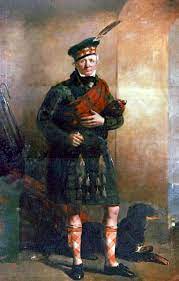Note: Extracted from Red Book of Scotland, Fifth Series (2025) Volume 10, pp. 29-31.
The surname MacNab or “Mhac-an-Aba” is Gaelic in origin and translates as the “son of the Abbot” to signify a descent, real or believed, from such a churchman whom Clan tradition asserts to have been an 8th-century Abbot of Glen Dochart.
John de Glendochart who appears as witness to a charter by Malduin, Earl of Lennox, granting to God and to the Abbey of Paisley his the lands of Cochmannacg, Edinbernach and others, belonging to the church at Kirkpatrick on 3 March 1238/9[1] is claimed as an ancestor.
Malcolm de Glendochart, apparently his son and heir, has also been brought into the MacNab’s ancestral fold. He witnessed charters by Malise, Earl of Strathearn, firstly, granting the lands of Kincardine to Sir David de Grahame between the years 1259×1272[2] then for those of Strathy and Prony to his sister, Marie, on the kalends of March 1268/9[3] and gave homage to Edward I of England at Berwick-on-Tweed on 28 August 1296.[4]
Patrick de Glendochart, also gave homage to Edward I at Berwick-on-Tweed on 28 August 1296.[5] He was a member of the inquest which convened at Perth on Thursday 17 September 1304, before John, Earl of Atholl, to hear the pleas of Malise, Earl of Strathearn, and Sir John de Moubray for the former having laid waste to the latter’s lands of Methven and taking the castle there in retribution for Sir Roger’s father having withdrawn from the king’s peace at the beginning of the war.[6]Although nothing further is known of him, should there be a basis of fact to the tradition of the MacNabs having had kinship with the pro-English Lords of Lorn and aligned with them during the Wars of Independence which ravaged Scotland in the last years of the 13th and the first decade and a half of the following century, the events of that dramatic period of history would have fallen within his lifetime. At the battle of Dalry in 1306, the act of wrenching the Brooch, one of the Clan’s prized trophies from antiquity, from the breast of Robert the Bruce may reasonably be attributed to him.
The fall of those Lords of Lorn after Bannockburn in 1314 and the loss of the entirety of their extensive landed possessions in the western highlands is a matter of record and it follows that a similar fate would have befallen their more powerful allies and kin who had stood with them in opposition to the Bruce. Douglas remarks that “when king Robert prevailed, they [the Macnabs] suffered greatly, had their houses burnt, and all of their writs destroyed &c. &c.”[7] That too is consistent with evidence and following Bannockburn, the King granted the barony of Glendochart to his faithful companion-in-arms, Alexander Menzies of Weem.[8] In the wake of King Robert’s death in 1329, the landless Lords of Lorn having lived in exile in England and become reduced to pleading for succour from an indifferent Edward III in June 1320,[9] had been rehabilitated by the new King, David II, and restored by him to a sizeable portion of their ancestral lands before September 1338.[10] Such a chronology and circumstances are mirrored by the MacNabs own fortunes and vicissitudes to a degree that it would be reasonable to conclude that any rehabilitation of those Lords of Lorn had been extended to their allies, and in 1336 Gilbert McNab received a charter from King David for the lands of Bovaine which likely also included Ardchoille, Duffince, Innermonechele and the office of Farbalschip of the lands of Auchlyne, all of which comprised the heritage enjoyed by his descendants.
Gilbert MacNab of Bovaine, who received the charter from David II. for the lands of Bovaine in 1336[11] was likely the son or at least the heir-male of Patrick of Glendochart and is the first Chief of the surname for whom there is evidence but of whom nothing beyond the receipt of that charter is known. The next for whom there is evidence is;
Alexander MacNab of Bovaine, who, about the year 1398, had a charter from Robert Stewart, Duke of Albany and “lord of Glendochart,” to himself and his son John and their heirs male for the lands of Ardchoiletir, Innermonechele, Bothemeghan and Dovinche, in the barony of Lochdochart, from Robert, Duke of Albany,[12] and died before 16 December 1407. He had issue, for which see MacNab of Bovaine and MacNab, Volume 10, Red Book of Scotland.
____________________
[1] Reg. de Passelet, pp. 160-161.
[2] GD220/1/A/1/3.
[3] Inchaffray charters, app. v.
[4] Cal. Docs. Scot. Vol.2, p. 199.
[5] Cal. Docs. Scot. Vol.2, p. 199.
[6] Cal. Docs. Scot. Vol.2, no. 1592.
[7] Baronage, p. 389 (Sir Robert Douglas, Edinburgh, 1798).
[8] RMS Vol. 1, app ii, no. 476.
[9] Cal. Docs. Scot, Vol. 3, no. 699.
[10] Keir charters, no. 2.
[11] Robertson’s Index. RMS I, app, 2, 1527 and n.
[12] GD112/2/34/1. Which is the earliest surviving MacNab writ.
